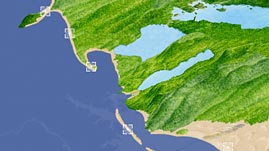Teachers' Domain - Digital Media for the Classroom and Professional Development
User: Preview

Source: National Park Service
Waves play a major role in breaking down and building up coastline features. But other factors, including tides, currents, and sediment type, also determine how erosional and depositional processes shape coastlines. In this interactive resource adapted from the National Park Service, learn about beaches, spits, and other sandy landforms that characterize some of America's coastal national parks.
Where land and oceans meet, two basic types of coastlines exist: rocky coasts, which are formed primarily by erosion, and sandy coasts, which are formed primarily by deposition. Sandy coasts are typically located on passive margins — the trailing edges of tectonic plates that are characterized by a gently rising shelf.
As waves stir up coastal sediments and the undertow draws them offshore, longshore currents transport these sediments parallel to the shore. Eventually, when the sediment-carrying water arrives at a lower-energy environment — where long, shallow bottoms or sheltering landforms prevent large waves from forming — the sediment settles to form features such as beaches, barrier islands, dunes, and spits.
Beaches are sloping bands of deposited rock and other hard material fragments that form along a shoreline. Depending on the source material, the sediment may be fine or coarse, and white, black, or some other color. Beaches may form as long, crescent-shaped features, as well as in smaller, confined areas. Pocket beaches, for example, form between headlands, where wave action is subdued and as a result sediment eroded from cliffs and other rocky formations is deposited. Low-energy waves tend to build up beaches by depositing more sediment than they remove. High-energy waves tend to remove more material than they leave behind.
Barrier islands are narrow strips of sand that, when left in their natural, undeveloped state, experience constant change and movement. These landforms protect the mainland from strong incoming waves and shield more fragile environments like marshes, tidal flats, and lagoons that lie further inland. Another feature of sandy coasts are dunes, which may form anywhere that wind deposition occurs. Dunes provide much-needed protection to back-barrier environments, including human developments, from severe wave, wind, and storm events.
Cape Cod is a barrier spit — a landform that results from the deposition of sediments in long ridges that extend outward from a coast. If a barrier spit grows long enough, it can completely cut off a bay from the ocean, creating a lagoon.
Every day along all sandy landforms, wind, waves, and currents move sand, pebbles, and other small materials along the shore or out to sea. Shorelines also change seasonally, tending to build slowly during the summer months when sediments are deposited by relatively low-energy waves, and erode dramatically during the winter when sediments are moved offshore by high-energy storm waves.
 Loading Standards
Loading Standards Teachers' Domain is proud to be a Pathways portal to the National Science Digital Library.
Teachers' Domain is proud to be a Pathways portal to the National Science Digital Library.
